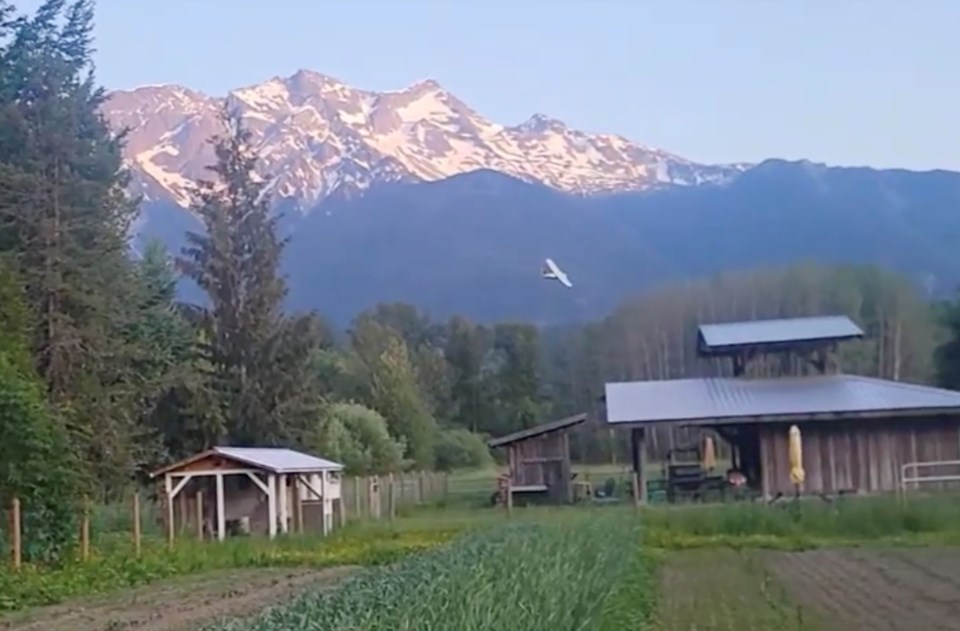Transport Canada is looking into reports about a plane some Pemberton residents say they saw flying at a dangerously low altitude last month.
Pemberton local David Gilman said he was at home on Thursday evening, June 1 at about 8 p.m. when he noticed a small plane “flying pretty much over top” of his property.
He thought the aircraft was in distress until its pilot conducted “five low-level passes—and by low-level I mean [they were] just above the treetops”—over the Village of Pemberton over a span of about five or six minutes, before climbing out of the valley.
Gilman said he, his children and his tenants exited their home for safety. “You don’t want to be in a structure if it gets hit by a plane, you want to be outside,” he said.
“It was just so scary to have a plane flying over your house, like within 100 to 200 feet, with no explanation as to why that was necessary.”
The Cessna Gilman observed on June 1 features a visible wing mark: CF-PUP. According to the public Canadian Civil Aircraft Register, that aircraft is privately registered to a Whistler resident named Tyler Nicholson. The same plane appears in photos posted to a public Instagram profile belonging to Nicholson, a snowboarder who competed for Canada at the 2018 Winter Olympics.
In an email, Transport Canada senior communications advisor Hicham Ayoun confirmed the event Gilman described has been reported to the federal department. “We are aware of the incident and are following up to review the circumstances,” the spokesperson said. “Transport Canada reviews all complaints and reports of possible violations involving any aircraft to determine if an investigation is warranted and whether an offense has occurred under the Canadian Aviation Regulations. Local police may also be involved if other laws were broken.”
Cst. Katrina Boehmer of the Sea to Sky RCMP said the local detachment “received a call about an aircraft flying dangerously,” but said the matter was referred to the independent Transportation Safety Board.
“Investigations involving Aeronautics Act violations fall under the Transportation Safety Board’s mandate, and any violations would be investigated by them,” she explained.
Transport Canada is responsible for regulating the country’s federal aviation laws. That includes the Canadian Aviation Regulations, which lays out minimum altitudes and distances pilots must adhere to while operating an aircraft.
According to those regulations, except when taking off or landing, aircrafts operating “over a built-up area” must fly at a minimum altitude of 1,000 feet above the highest obstacle within a horizontal distance of 2,000 feet from the plane. However, when not operating over a built-up area, pilots only need to keep at least 500 feet of distance between their aircraft and any person, vessel, vehicle or structure.
Whenever Transport Canada hears a complaint containing enough information to identify the pilot and verify that individual contravened the Canadian Aviation Regulations, the department could issue an administrative fine of up to $5,000, “or, depending on the nature and severity of the infraction, the pilot’s license may be suspended,” Ayoun wrote.
Transport Canada also publishes online lists of both Corporate Offenders and Non-Corporate Offenders “to both serve as a deterrent and to increase public awareness and education concerning aviation safety,” according to its website. Those lists are updated on a monthly basis, but don’t include names of or other personal information that could identify the individuals involved. All five penalties served to non-corporate offenders in May 2023 were for violations that took place between May and July last year.
The section of the Canadian Aviation Regulations encompassing altitude limits does lay out a few scenarios where low-altitude flights are permitted—for example, where aircrafts are carrying out fire-fighting or search-and-rescue operations, fixing infrastructure like power lines, conducting flight training, or for special events like airshows.
The legislation is less clear about what exactly constitutes a built-up area.
No formal investigation has since been launched, and any allegations of unsafe aircraft operations or aviation regulation violations have yet to be proven.
Transport Canada encourages anyone who witnesses unsafe or illegal flying activity to contact the department through its online portal, wwwaps.tc.gc.ca, and include as much information as possible, like clear photos or videos, dates and times, aircraft registration, and other identifying marks.
Nicholson did not immediately respond to a request for comment. Check back with Pique for updates to this story.




